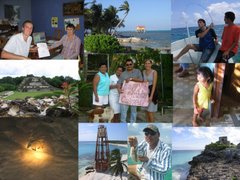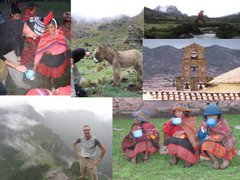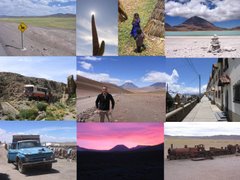
You thought I’d given up didn’t you!
Ok, so it’s been more than two months. And that's not good. But winter isn’t a good time for me. I tend to go into a semi-hibernating state. Like a NASA robot on Mars, all non-essential systems are shut down to conserve power to survive until conditions are favourable for a return to full action. But it’s been 28C today. That’s enough to bring anyone out of hibernation. So – much belatedly – here’s an update on the most interesting part of my last trip to India...
SEWA Ashram is a volunteer-run refuge for the destitute homeless people of Delhi. Opportunity International has a connection with the Ashram through their shared mission to provide opportunities to the impoverished, in response to Jesus Christ’s call to serve the poor. In July 2008, I visited SEWA Ashram’s one-and-a-half acre site, just north of Delhi, to see first-hand the challenges faced by the Ashram in providing medical care, shelter and rehabilitation to around 150 of the most vulnerable people on the very fringes of Indian society.
As we approach the main entrance of the Safdarjung hospital, one of Delhi’s largest hospitals, Nino spots a guy sitting on the bare ground. He could be around 20 or 30, or older. It’s hard to tell. He has a filthy bandage around his right leg. He looks confused, drugged even.
“This guy is typical,” Nino tells me, “he knows he needs help, he knows this is the hospital, this is where the care is, but what he should do next… he has no idea.”
“This is what it means to be destitute and ill in Delhi.”
Nino, one of the two volunteers who run Sewa Ashram, had picked me up from my comfortable central-Delhi hotel that morning.
As a veteran of 16 months working with the poverty-stricken in Delhi, Nino had volunteered to give me a ‘day-in-the-life” of SEWA Ashram. We would visit the Ashram itself, take a tour of the Delhi streets where they find most of their patients, and visit one of the government-run hospitals in Delhi, where I would see the challenges facing those who want to do something for the welfare of the poorest.
Softly spoken, passionate, and thoroughly non-judgemental, Nino is a great teacher. Spending time with Nino is learning about poverty at the coal-face. Everything Nino does seems to be a product of both a passion to change, and an acceptance of what is. At first glance, these two things might seem incompatible but I learn from Nino that a real, respectful and lasting contribution to the problems of poverty in Indian society comes from managing the clash between these two emotions.
After a few minutes we are driving through Delhi’s chaotic morning traffic in the tiny Toyota that doubles up as delivery van and ambulance for the Ashram. As with much else in India, Delhi’s traffic problems are pretty much the same as anywhere else in the wo
But imagine chaos in a hospital. That is something far more harmful. What more difficult time to manage stress, confusion and disorientation than when one is ill?
Unfortunately, in Delhi, this too is a fact of life – for the poor at least. The young guy lying on the ground in front of us is a victim of this chaos, and it’s when Nino and I walk through the front entrance of the hospital, that I realise why. And I also start to understand what it really means to be poor and ill in Delhi.
Getting care and attention is a fight against a multitude of obstacles. The first problem is finding the right department. With no reception desk, and no obvious staff to direct you, it’s difficult to know where to start. There are signs, yes, but if you are illiterate how do you know where to go? It’s not hard for me to imagine this problem – with my extremely limited Hindi, the Hindi script is meaningless.
Maybe if you are self-assured, assertive and well-spoken you can find someone who will help you find where you want to go. But many of the poorest lack the confidence and strength that they need to help themselves.
Moving beyond the entrance hall, Nino takes me round to one of the hospital’s main admission departments where maybe as many as 50 people are waiting in two queues to see a doctor. This is the key to being admitted to the hospital – to be seen by a doctor and for him to assess your condition and decide that you should be admitted. It sounds straight-forward, but…
Some people will wait here all day, just in the hope of getting their few minutes with the doctor. And though the hospital is clean, the atmosphere is intimidating. It’s busy, noisy and dark, more like a city-centre bus station than any hospital I’ve been in before. We stay for a few moments and I feel a real desire to be able to help, mixed with not a little helplessness.
But as well as showing me the problems, Nino also wanted me to understand from the start that this hospital was not only of a better standard than many of the other hospitals in Delhi, but also on a steady – and in places rapid – curve of improvement. The A&E ward has modern trolleys and expensive diagnostic equipment. Two new large buildings are being built next to the main hospital building, to provide specialist surgery and care.
And past the admissions department, I see patients who are being treated, and treated well. In the Orthopaedic Department, we visit a ward that is bright and well-equipped. And the staff we talk to are caring and attentive.
But though things are improving, people still fall through the safety net.
In the ward, Nino introduces me to a sometime patient of the Ashram. The man lying in the bed in front of us had tried 15 times to be admitted for treatment for a badly fractured leg. Not all of those attempts had been unsuccessful. Through a misfortune which would have caused me to lose my senses, he had been admitted on one occasion, only to be thrown back on the streets when the nursing staff in the department had – for what may well have been very understandable reasons – gone on strike.
We spend some time with the patient, and Nino talks to one of the nurses. The Ashram staff have a good relationship with the hospital, built up over time and through personal connections. Many of the things that make a difference in public healthcare in India appear to me to be dependent more on trust and personal motives than policies or regulations.
As we leave, we pass the admissions department again. Looking at the long queues of weary patients, I see some determination, some resignation and plenty of bewildered, confused looking people. It strikes me that this weighting room is like a force-field, bouncing back the weak, and those lacking in confidence.
Back outside the hospital again, we see those who have neither the capability, nor the help from relatives to breach this force-field. In the competition to be admitted to the hospital it is the weakest who lose out. And around the Safdarjung hospital, you can see them sitting on the steps and lying under the trees and at the corners of the buildings.
After the visit to the hospital, Nino and I drive over to the streets around the Yamuna, the river that cuts through the Eastern half of New Delhi.
The van pulls up under one of the city’s newly built overpasses, and I can see a number of figures sitting or lying in the shade, taking some relief from the pre-monsoon sun. As we park up, someone approaches the van and directs our attention to one figure lying on the ground.
As we approach him this figure looks notably different to others I’ve seen sitting at the side of Delhi’s roads. Firs
But back at the Ashram, some kind of future can be offered. The first step was to take the new patient to the clinic in the local village for chest x-rays to assess the extent of the damage. Then a prescription would be made for the patient (at least 6 months of drugs in the case of TB), followed by education for the patient. In the case of TB, a disease all but forgotten in the developed world, success of the treatment is dependent on strictly following the prescription. All this could happen in the clinic over a couple of days. Recovery and rehabilitation would take many months, hence the need for the safe and loving environment provided by the Ashram.
In fact, by the end of that day the impact of the Ashram was already obvious. The guy we had picked up off the streets was lying on a sarpoy (a simple Indian bed). He had been at the Ashram for just a few hours but already looked like any of the other residents. For a moment my mind couldn’t quite grasp how quickly he had become part of the community.
I wondered why this seemed so odd to me. The answer was in my own experience and prejudice. I was used to the idea that, to become part of a group, especially a group that offers love, care and community, there is a kind-of ‘probationary period’ when you are not afforded the privileges, trust and rights of established members.
I was seeing this guy as a ‘new patient’, when in fact there is no such distinction at the Ashram. He was part of the community from the moment he arrived.
I wondered if I should feel encouraged that we had ‘saved’ him, made a difference. But I remembered too what Nino had said about the false impression that could be picked up from a visit to the Ashram site, about how the picture was only half-complete without seeing what was outside the Ashram.
My thoughts turn to all the people who we had seen earlier in the day who didn’t have this opportunity. As easily as some are ‘saved’, many others were just as easily left out. It unsettles me that there could be such a difference in outcome, for want of so little. My mind races on. How can I sit aside and accept that people are just as easily left outside, sleeping under bridges, alone, with serious, untreated, bewildering mental and physical problems?
I was also troubled that finding answers to these questions was more about addressing my guilt. I had felt good that one person had been saved, and this made me wonder at how it was possible that people could just stand by and let people suffer for so little. But this was to misunderstand the whole nature of the problem. Poverty is about the big picture in Delhi. Lasting solutions – as Nino fully appreciates – need an understanding of what is, as well as a will to change.
SEWA Ashram, with the assistance of Opportunity International, are currently considering options for expanding their existing operation, both in size, and through providing more sustainable solutions to the problems facing Delhi’s destitute homeless.












